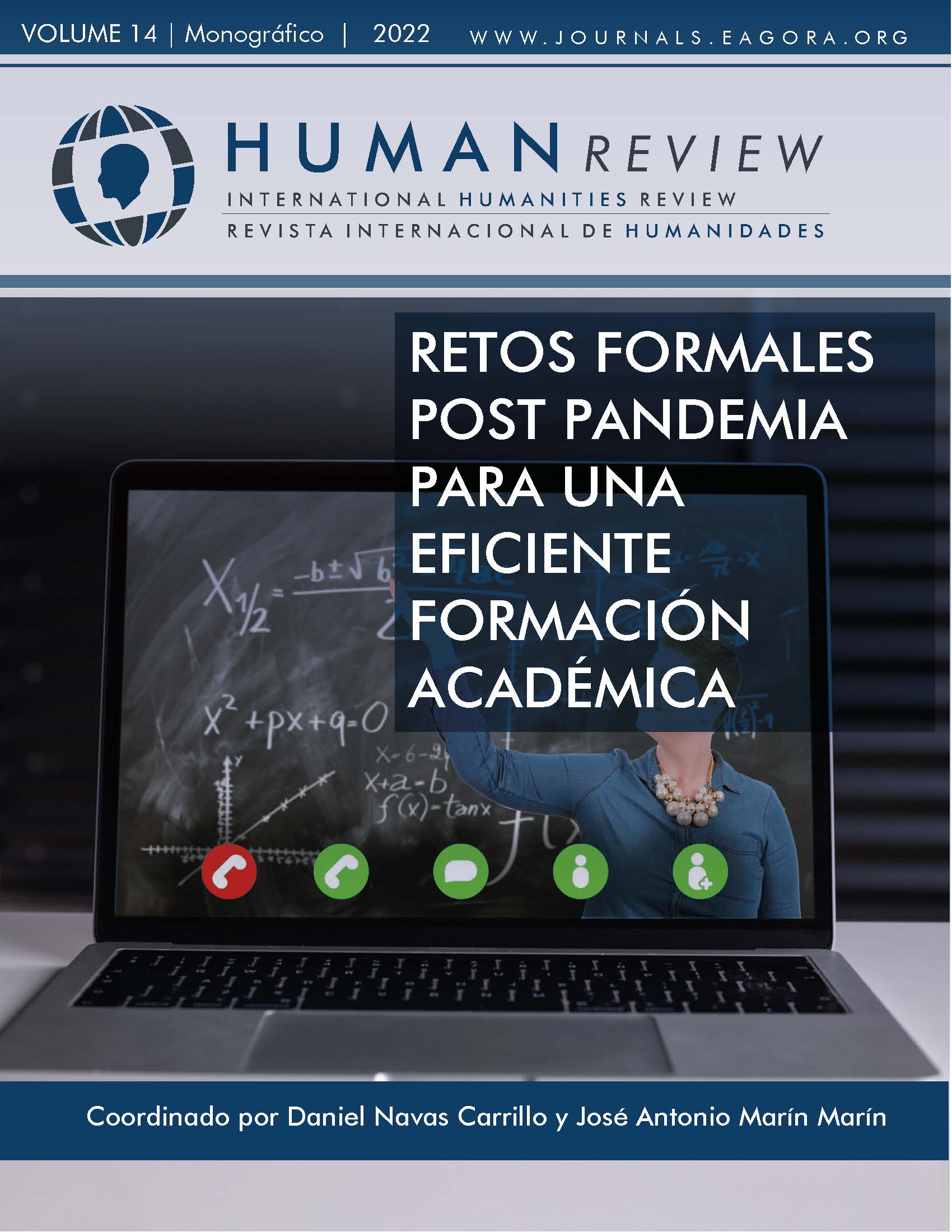Modeling the role of nursing in school health control
Implementation through audiovisual instruments
Keywords:
Modeling, School health, Virtual class, Family nursing, PandemicAbstract
The pandemic forced the suspension of practical activities of the nursing career, adapting them to the online modality, making it difficult to develop the procedural skills of the students. As an alternative, 6 demonstrative audiovisual capsules of a control were built, with the subsequent explanation of these. It stands out that 90% of the students developed the skills, 84% passed the unit test and 87% strongly agree that the strategy facilitated their learning. It is concluded that the modeling strategy with audiovisual media is an effective methodology for the development of these skills.
References
Adame, A. (2009). Medios audiovisuales en el aula. Revista Digital de Innovación y Experiencias Educativas, 19, 1-10. https://bit.ly/3BxM7Tb
Agama-Sarabia, A., Trejo-Niño, G., De la Peña-León, B., Islas-Ortega, M., Crespo-Knopfler, S., Martínez-Felipe, L. y González-Velázquez, M.S. (2017). Recursos audiovisuales en la educación en enfermería: revisión de la literatura. Enfermería Global, 16(47), 512-538. https://doi.org/10.6018/eglobal.16.3.260621
Arboccó de los Heros, M. (2015). Neurociencias, educación y salud mental. Educación, (21), 11–19. https://doi.org/10.33539/educacion.2015.n21.1047
Bandura, A. (1971) Social Learning Theory. General Learning Press.
Bates, A. W. y Poole, G. (2003). Effective teaching with technology in higher education foundations for success. Cjsae rcééa, 19(1), 77-79. https://cjsae.library.dal.ca/index.php/cjsae/article/view/1824/1587
Baxto, W. y Quintão – Carneiro, V. (2019). Uso da TIC na educação superior a distância. Educação, 42(1), 35-43. http://orcid.org/0000-0002-6716-7353
Braaksma, M. A., Rijlaarsdam, G. y van den Bergh, H. (2002). Observational learning and the effects of model-observer similarity. Journal of Educational Psychology, 94(2), 405-415. https://doi.org/10.1037/0022-0663.94.2.405
Boude-Figueredo, O. y Medina-Rivilla, A. (2011). Educación médica superior, 25(3), 301-311. https://bit.ly/3aAb8lJ
Cabero-Almenara, J. (2002). Propuestas para la utilización del video en los centros. Universidad de Sevilla. 1-28. https://acortar.link/fSF9Bo
Contreras, J. y Sepúlveda, C. (2015). El modelaje como fuente de aprendizaje (2º edición). VALORAS, Pontificia Universidad Católica de Chile. www.valoras.uc.cl
Díaz-Vera, J.P., Ruiz-Ramirez, A.K. y Egüez-Cevallos. (2021). Impacto de las TIC: desafíos y oportunidades de la educación superior frente al Covid-19. Uisrael, 8(2), 113-134. https://doi.org/10.35290/rcui.v8n2.2021.448
Fryling, M., Johnston C. y Hayes L. (2011). Understanding observational learning: an interbehavioral approach. The análisis of verbal behavior, 27(1), 191-203. https://doi.org/10.1007/BF03393102
García-García, E. (2008). En neuropsicología y educación. De las neuronas espejo a la teoría de la mente. Revista de Psicología y Educación, 1(3), 73. https://www.revistadepsicologiayeducacion.es/pdf/27.pdf
García-Valcárcel, A. (2008). El hipervídeo y su potencialidad pedagógica. Revista Latinoamericana de Tecnología Educativa, 7(2), 69-79. http://campusvirtual.unex.es/cala/editio/
Granada-Asencio, L.Y., Espinoza-Freire, E.E. y Mayon-Espinoza, S.E. (2019). Las TICs como herramientas didácticas del proceso de enseñanza-aprendizaje. Revista pedagógica de la Universidad de Cienfuegos, 15(66), 104-110.https://bit.ly/3z0UaGl
Gobierno de Chile (15 de Marzo de 2020). Presidente Piñera anuncia nuevas medidas para frenar el avance del coronavirus. https://bit.ly/3Ryswrt
Gómez-Hurtado, I., García-Rodriguez, M., Gonzalez-Falcón, I. y Coronel-Llamas, J. (2020). Adaptación de las metodologías activas en la educación universitaria en tiempor de pandemia. Revista internacional de la educación para la justicia social, 9(3), 415-433. https://doi.org/10.15366/riejs2020.9.3.022
Hurtado-Talavera, F. J. (2020). La educación en tiempos de pandemia: los desafíos de la escuela del siglo XXI. Revista arbitrada del centro de investigación y estudios gerenciales, 44, 176-187. https://repositorio.cepal.org/bitstream/handle/11362/45904/1/S2000510_es.pdf
Merchán-Basabe, C. A. (2018). Modelamiento pedagógico de ambientes virtuales de Eaprendizaje (AVA). Tecné, Episteme y Didaxis, (44), 51-70. https://dialnet.unirioja.es/servlet/articulo?codigo=6836861
Ministerio de Educación (s.f). Priorización curricular. https://bit.ly/3APsNk3
Ministerio de Educación. (s.f). Integración educativa de las TIC: perspectivas actuales. https://bit.ly/3o8bGC9
Montalvo-Charles, G., Torres-Jiménez, J. y Parra-González, E. (2021). Las tecnologías de la información y la comunicación (TIC) en la educación a distancia durante la pandemia Covid-19 utilizadas en educación primaria. Dilemas contemporáneos: educación, política y valores, 9(42), 1-22. https://doi.org/10.46377/dilemas.v9i.2949
Nicolau, C., Matsiola, M. y Kalliris, G. (2019). Technology-Enhanced Learning and Teaching Methodologies through Audiovisual Media. Education Sciences, 9(196), 1-13. https://doi.org/10.3390/educsci9030196
Poveda-Pineda, D. y Cifuentes-Medina, J. (2020). Incorporación de las tecnologías de información y comunicación (TIC) durante el proceso de aprendizaje en la educación superior. Formación Universitaria, 13(6), 95-104.http://dx.doi.org/10.4067/S0718-50062020000600095
Quiroga-Baquero, L.A., Padilla-Vargas, M.A., Ordoñez-Riaño, S. y Fonseca-León, L.C. (2016). Efectos de diferentes tipos de entrenamiento por modelado en tareas de igualación a la muestra. Revista latinoamericana de Psicología, 48, 18-29. https://doi.org/10.1016/j.rlp.2015.09.001
Reigeluth, C., Myers, R. y Lee, D. (1999). Fundamental principles of the learner-centered paradigm of education. En: C. Reigeluth, B. Beatty y R. Myers (Eds). Instructional-desing theories and models (Volume IV): The learner-centered (pp. 5-29). Lawrence Erlbaum Associates https://bit.ly/3uO43EK
Sandoval-Benavides, V.L., Organista-Sandoval, J., López-Ornelas, M. y Reyes-Robinson, S.A. (2020). Elaboración de módulos audiovisuales para mejorar las habilidades digitales de estudiantes universitarios. Apertura, 12(2), 1-22. http://dx.doi.org/10.32870/Ap.v12n2.1893
Schwartz, D y Hartman, K. (2007). It is not television anymore: designing digital video for learning and assessment. En: R. Goldman, R. Pea, B. Barron y S. Derry (Eds.). Video research in the learning sciences (pp. 335-348). Routledge. https://bit.ly/3Pe3xZa
Vargas-Murillo, G. (2017). Recursos educativos didácticos en el proceso enseñanza aprendizaje. Cuadernos Hospital de Clínicas. 58(1), 68-74. https://bit.ly/3cgogMY
Downloads
Published
Issue
Section
License
All articles are published under an Attribution-NoDerivatives 4.0 International (CC BY-ND 4.0) license. Authors retain copyright over their work.

